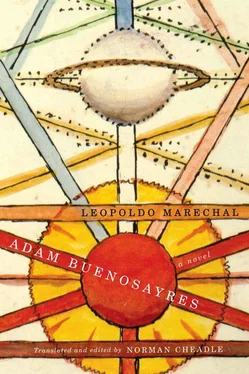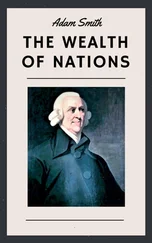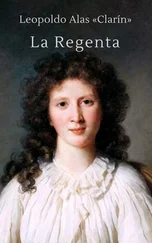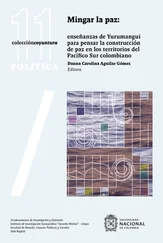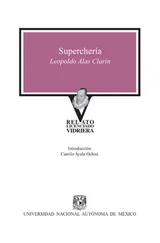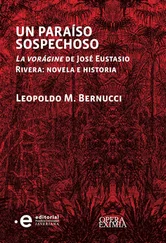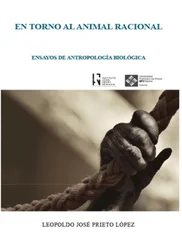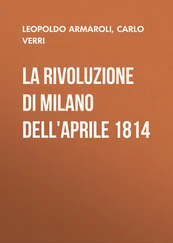GENEALOGIES (RELIGIOUS, IDEOLOGICAL, LITERARY)
The young writer Cortázar was both disconcerted and excited by what he enigmatically called the diversa desmesura of Marechal’s novel (original Spanish version 23), its hypertrophic excess on various levels — perhaps its monstrous hybridity — which rationally he perceived as an inadequate matching of structural form to content but which intuitively the writer in him grasped as this novel’s aesthetic achievement, its “energetic push toward what is truly ours [in Argentine literature]” (24). As Ángel Rama put it, in Adán the forms of high culture meet those of popular culture in a parodic oscillation, with the net effect that the former are destabilized along with their philosophical underpinnings (216–17). By “high culture” one must understand the allusions not only to classical Greece and Rome, but also to the Bible — Northrop Frye’s “great code” — and to Catholic theology. Marechal himself insists that the “keys” to his novel are to be found in two parallel lines of thought stretching from Aristotle to Saint Thomas and from Plato to Augustine (Andrés 32); he interprets Adán Buenosayres as a Christian allegory, the soul’s odyssey through the world and its eventual homecoming in God (Marechal, “Las claves”). A Catholic-theological reading of the novel is certainly possible — Navascués’s narratological study and the introduction to Barcia’s scholarly edition are fine examples — but much of the novel’s material seems to overflow this ideological framework, to the point of rudely shaking or even damaging the frame itself. Argentine critic Horacio González once mused about the novel’s “comical,” “ironic,” or even “broken” Christianity. 19Even if one enlarges the Christian-epic reading to an ecumenical “metaphysical” interpretation, as Graciela Coulson does in order to account for the many allusions to non-Christian traditions, the essential problem only gets displaced, not resolved. Suffice it to say here that different readers, according to their cultural formation, will have different takes on Adán Buenosayres . As with all great works of literature, it is a novel that no single critical reading can exhaust.
Adam Buenosayres and his close friend and confidant, Samuel Tesler, are both “traditionalists” who move in a discursive world informed by such radical traditionalist authors as René Guénon, whose voluminous output includes the apocalyptic Le règne de la quantité et les signes des temps (1945) and who attempts to conflate the metaphysical systems of the world’s great religions in a single block that stands superior to the error of modern thought. The two “metaphysicals,” 20Adam and Samuel, make common cause against the positivist scientism of Lucio Negri. (The third “metaphysical” is the astrologer Schultz, who like Xul Solar could be described with the paradoxical term “avant-garde traditionalist.”) And yet, Adam will eventually rebuke Samuel for his Jewishness, invoking the hoary myths invented by medieval anti-Semitism. As in most traditional Catholic societies, a degree of anti-Semitism — a frightening term for us since the Second World War — was still quite normal in 1920s Argentine society. The Jews (mostly from Russia and Eastern Europe), along with the Italians, Galician Spanish, “Turks” (refugees of varying ethnicity from the crumbling Ottoman Empire), and so on, were cast as stereotypes in the popular imaginary; Marechal’s novel humorously sets those popular stereotypes on display. The Jews, the odd anti-Semitic incident notwithstanding, were in the mind of the Catholic criollo majority just one distinct minority among others. Nevertheless, the rise of Argentine Catholic nationalism, under the influence of a new outbreak of a very old virus emanating from Europe, was accompanied in some circles by a more virulent expression of anti-Semitism. Although the centuries-old prejudice was deeply racialized, the more thoughtful Catholic-nationalist intellectuals attempted to confine it to a religious question: the Jews’ failure to recognize Christ was a theological error from which they needed to be disabused. Manuel Gálvez, for example, professed his love for the Jews. This love, which he considered to behoove any good Catholic, did not, however, prevent his endorsing negative Jewish stereotypes (Schwartz 131–2). Gálvez — as well as Adam Buenosayres and perhaps even Marechal himself 21— could well be examples of what Máximo José Kahn in 1948 called “philo-Semitic anti-Jewishness,” referring to those who are philo-Semitic “by civilization” and anti-Jewish “by instinct” (Kahn 48). 22And yet, parsing this paradox further in his incisive but (deliberately?) enigmatic article, he opines that atheism is worse than philo-Semitic anti-Jewishness (57), even if the unbeliever seems to be on your side. Here he seems to refer to those liberals who waved the banner of anti -anti-Semitism as part of their anti-Peronist campaign, their negative philo-Semitism militantly expressing, within the perfectly polarized ideological field of the time, their hatred of Peronism and its supporters, which initially included the Catholic church. 23Adam and Samuel have their differences, but they are united against modern non-religious scientism. Both men locate themselves squarely in what Israeli historian Zeev Sternhell has called the tradition of the “anti-Enlightenment,” the many-faceted revolt against the Franco-Kantian Enlightenment that constitutes a second, parallel modernity (8).
Reading the frank anti-Semitism on display in a few passages of Adán Buenosayres is a complicated business, not only because of the paradox of anti-Jewish philo-Semitism but also because of the novel’s polyphony. The shifting and parodic narrative voice makes it hazardous to ascertain precisely the pragmatic ethos of any given passage. What is certain, however, is that Adam Buenosayres dies and Samuel Tesler lives on to play a part in Marechal’s third novel, Megafón, o la guerra (1970), the only one of his fictional characters to do so. 24
From a strictly stylistic perspective, one finds another index of diversa desmesura in the juxtaposition of the earnest, spiritualist, neo-Dantian prose of Adam Buenosayres’s “Blue-Bound Notebook” with the novel’s Rabelaisian tremendismo , to use Marechal’s own term for his conscious emulation of Maître François. The humorous contrast of high and low, the spiritual and the coprological, stems as well from Miguel de Cervantes’s legacy, worth recalling here for the benefit of English-speaking readers. 25Besides the Cervantine device of the “found manuscript” mentioned above, Marechal, as Cervantes does in Don Quixote , interpolates into the text lengthy stories that serve as functional instances of mise-en-abyme ; the stories told in Cacodelphia by The Man with Intellectual Eyes and by Don Ecuménico are salient examples. Another meta-literary technique bequeathed by Cervantes is to provide commentary, either directly or by allusion or by parody, on diverse texts of various genres, literary and otherwise. The Argentine component of Adán ’s meta-literary discourse is what particularly struck Piglia: “A novelist constructs his own genealogy and narrates it; literary tradition is a family saga. In Adán , origins, relationships, endogamic successions are all fictionalized. Marechal treats the struggle among various Argentine poetics with the ironic tone of a (Homeric) payada [literary duel in the gauchesque tradition]” (xvi).
In the notes accompanying this edition of the novel, the reader will find explicated many — not likely all! — such allusions to Argentine literature. For example, José Mármol’s foundational novel Amalia (1851) — a Manichean melodrama pitting noble unitarios against the evil federales of the Rosas regime — is prominently referenced at the outset of Adán Buenosayres . Equally significant, perhaps, is that another foundational text of Argentine literature — Esteban Echeverría’s short story “El matadero” (circa 1939) [The Slaughterhouse] — is seemingly effaced from Marechal’s literary genealogy. Echeverría memorably made the slaughterhouse a symbol of the bestial ferocity of the Rosas regime and its supporters (the Church and the lower classes). But Marechal, on the first page of Book One, evokes the slaughterhouse merely as a feature of the urban landscape and a symptom of “the world’s voracity.” If his image of the slaughterhouse carries any political valence at all, it refers not to the context of Argentine national politics, but rather to the geo-economic/political order: chilled beef — the term appears in English more than once in Adán — was being shipped from the refrigerators of the slaughterhouse in Buenos Aires to “voracious” Europe.
Читать дальше
